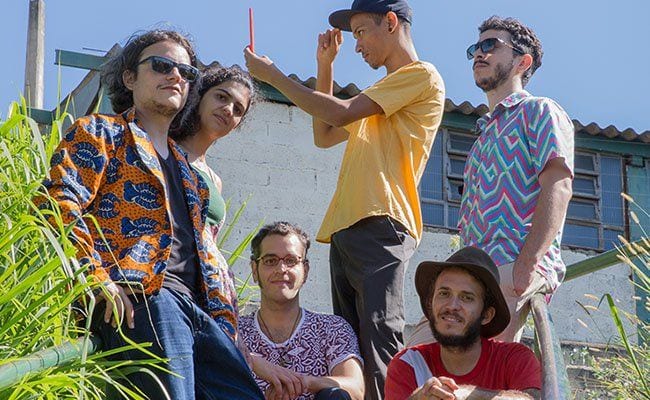
From the first few notes of Camaleão Borboleta, it’s tempting to compare Graveola to decades’ worth of its countrymen. On opening track “Maquinário”, singer Luiz Gabriel-Lopes sounds almost identical to a young Caetano Veloso, and the Tropicália spirit thrives throughout the album as Graveola experiments with psychedelia and West African-inspired rhythms. Echoes of more esoteric artists like Os Mutantes and Tom Zé touch each song, as well, and penultimate track “Back in Bahia” directly references Gilberto Gil’s post-exile song of the same name.
But Graveola lives in the present, and its third album proves it with everything from songs about the trials and tribulations of living in the age of the Internet to the struggles and protests of native Brazilians during the anti-demolition protests leading up to the 2014 World Cup. An ode to smokable herbs and love songs about seas and summers help to round out an all-encompassing album.
While many lyrics focus on local sentiments and issues, Graveola’s eclectic musical style knows no borders. Samba melts into reggae, and other rhythms come from all directions, whether from neighboring Argentina or distant Cape Verde. Such variety and enthusiasm for experimentation usually keeps Camaleão Borboleta fresh, but backfires when the group doesn’t fully commit. Track “Aurora” opens with bright blasts of salsa-style horns that dissipate all too quickly. When the trumpets return, slow and mournful, it feels unnecessary, brass for the sake of brass.
More abstract experiments find more success. Vivid “Costi” twists and pulls a melancholy samba into a psychedelic masterpiece, laced with electric fuzz and crashing cymbals. Modern drums and an ominous hint of bass whip irrepressible protest song “Índio Maracanã” into a frenzy, taking traditional rhythms to the boiling point. Closing track “Carta Convite” takes a short, simple acoustic guitar song and adds the sounds of slow-moving printers with perfect pitch, a fitting and strange end to the release.
Going in so many directions at once makes it hard to pick any tracks that stand out from all the rest. Listened to straight through, however, Camaleão Borboleta charts a day-long journey through the vast cultural diversity of Brazil, from the sunny morning heard in “Maquinário” to the slower, starlit tracks marking the journey’s end. Some songs, especially the experimental ones, mark destinations, points along the way worth stopping to see. Others, more straightforward, classical tunes, do the traveling, scenery for the in-between stretches. Of these, the emotional “Back in Bahia”, written and sung by percussionist Luiza Brina, is perhaps the most accessible, not just because Brina sings in English, but because of its instant familiarity. Painted with the same brush as any classic bossa nova tune and further colored with electric strings, “Back in Bahia” rings bittersweet and beautiful.
Graveola always shoots for the moon, and often hits its mark, playing with electronic and tropical sounds that add layers of complexity and intrigue to its indie rock. Even when it misses the mark, though, there’s something to be learned, whether it’s a new sound or a style fusion nobody has tried before. Now three albums into its career, Graveola has proven itself to be a group with the guts to try everything once, and for the imperfections that brings, it also demonstrates a heaping amount of staying power. Wherever Graveola goes next, listeners will follow, as ready for musical triumphs as they will be for the inevitable bumps along the way.

